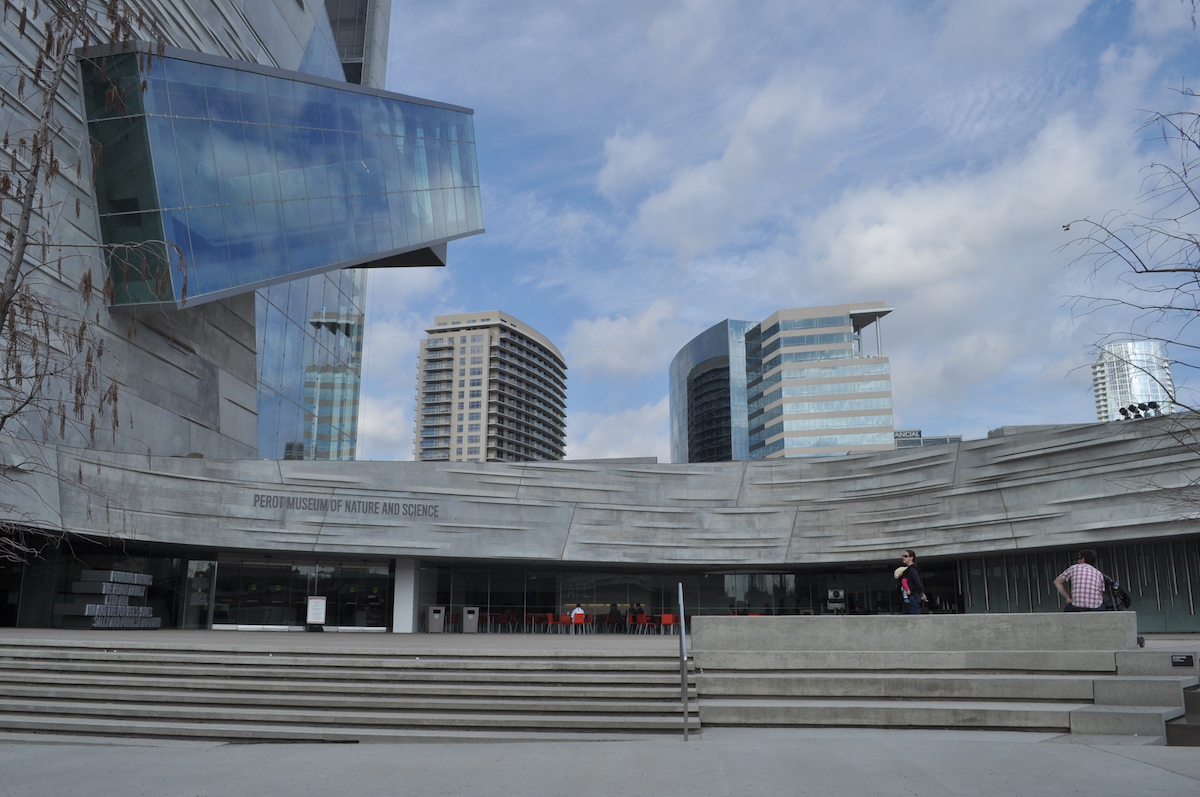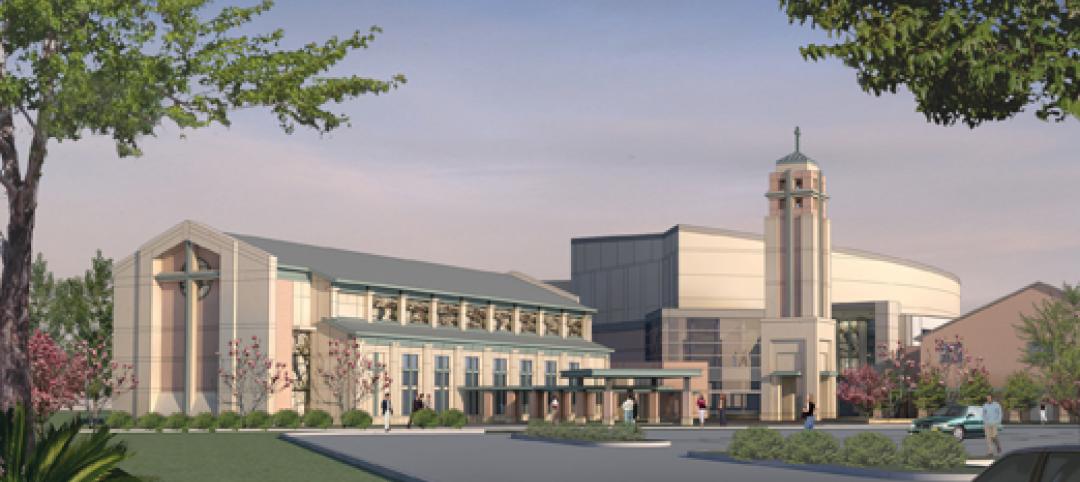The American Institute of Architects has selected 18 recipients of the 2016 Institute Honor Awards, the profession’s highest recognition for works that exemplify excellence in architecture, interior architecture and urban design. The 18 recipients, located throughout the world, were selected from around 500 submissions and will be honored at the AIA 2016 National Convention in Philadelphia. The winners were broken into the three categories of Architecture, Interior Architecture, and Regional and Urban Design.
The following is a recap of the winning projects (descriptions and images courtesy AIA). For more images or longer descriptions of the recipients, see the AIA’s report on the winning projects.
2016 Institute Honor awards for Architecture
The 2016 AIA Institute Honor Award for Architecture jury includes: Josiah Stevenson, FAIA (Chair), Leers Weinzapfel Associates Architects; José Alvarez, AIA, Eskew+Dumez+Ripple; Brad Cloepfil, AIA, Allied Works Architecture, Inc.; Roberto de Leon, AIA, De Leon & Primer Architecture Workshop; Julie Eizenberg, FAIA, Koning Eizenberg Architecture, Inc.; Julie Engh, Assoc. AIA, Highland Associates; Elizabeth Hallas, AIA, Anderson Hallas Architects, P.C.; Danielle Jones, AIAS Representative and Christian Zimmerman, FASLA, Prospect Park Alliance.
American Enterprise Group - National Headquarters Renovation; Des Moines, Iowa
BNIM
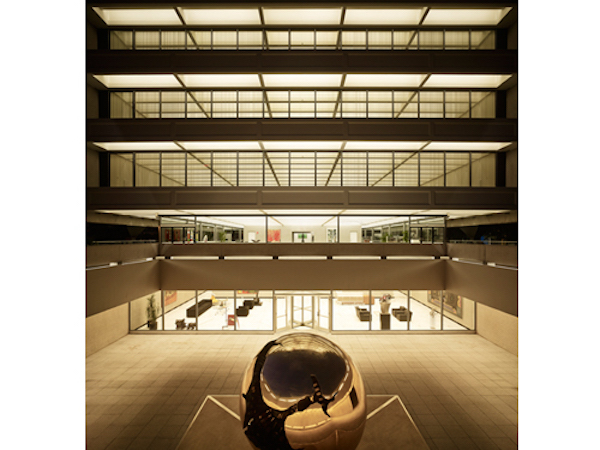 © Nick Merrick Hedrich Blessing
© Nick Merrick Hedrich Blessing
This project encompasses the nearly invisible rehabilitation of an eight-story office building designed by SOM’s Gordon Bunshaft, which received a 1967 AIA Honor Award for Architecture. Original systems were meticulously integrated with the building architecture. Rehabilitation required substantial demolition of the interior, which was obsessively reconstructed to accommodate new building and life-safety systems. The renovated space addresses human efficiency and evolving workplace standards with both systems and a minimal, modern office design that enhances human productivity while making AEG’s significant art collection an integrated part of the experience.
Asia Society Center; Admiralty, Hong Kong
Tod Williams Billie Tsien Architects | Partners; Associate Architect: AGC Design Ltd.; Associated Architects Ltd.
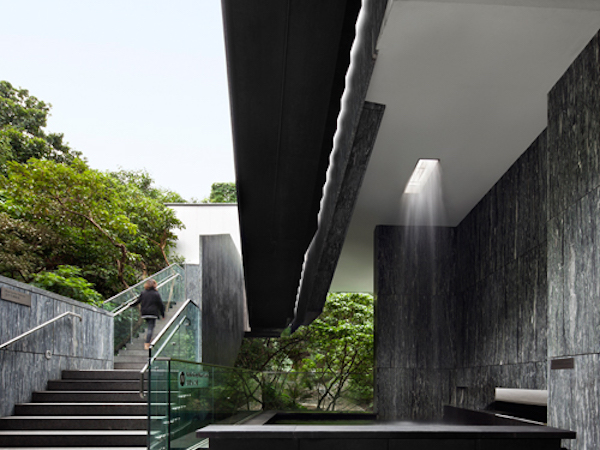 © Michael Moran / OTTO
© Michael Moran / OTTO
Combining historical buildings from the British colonial period with an angular footbridge and a glass-wrapped modern pavilion, the Asia Society complex in Hong Kong spans eras, cultures and styles. They connected the three 19th-century buildings to an extant 1940s structure via a footbridge that cuts a sharp "V" line through the verdant setting, and inserted a new 11,000-square-foot pavilion behind the younger building. The zigzagging bridge through the greenery, covered like many walkways in traditional Chinese gardens, yields expansive views of the city.
Case Inlet Retreat; Lakebay, Washington
MW Works | Architecture+Design
 © Jeremy Bittermann
© Jeremy Bittermann
The design brief called for a modern, low-maintenance abode that had a strong relationship with the land. The architects devised a solution whose simple forms unfold into the landscape, offering a unique interaction with the site in each room. The living space projects west into the tree canopy on a cantilevered platform, capturing views of the water and sunset. The kitchen reaches out through a sliding glass door to engage the meadow and the afternoon sun. The site permeates the building, through its ample windows and doors that bring in daylight, views of the Olympic Mountains and natural ventilation. Its concerted use of rugged, natural materials that complement what is found in the local landscape and also reinforces a sense of context and connection.
CHS Field; Saint Paul, Minnesota
Snow Kreilich Architects, Inc, Ryan A+E, Inc. and AECOM
 © Paul Crosby; Christy Radecic
© Paul Crosby; Christy Radecic
Working with the St. Paul Saints, an independent league franchise, and the City of St. Paul, the architects slipped a 7,000-seat ballpark into a remnant site between an interstate highway, an elevated bridge, a light-rail operations facility and the historic Lowertown District on the edge of St. Paul's business core. Wherever possible, the stadium is porous, opening itself to the life of the blocks around it. The main entrance frames the termination of Fifth Street, creating a vital connection to that core via an axial view along the street to the historic St. Paul Hotel. The sleek, low ballpark offers powerful views to the surrounding structures, many of them warehouses from the late 19th and early 20th centuries.
Henderson-Hopkins School; Baltimore
Rogers Partners
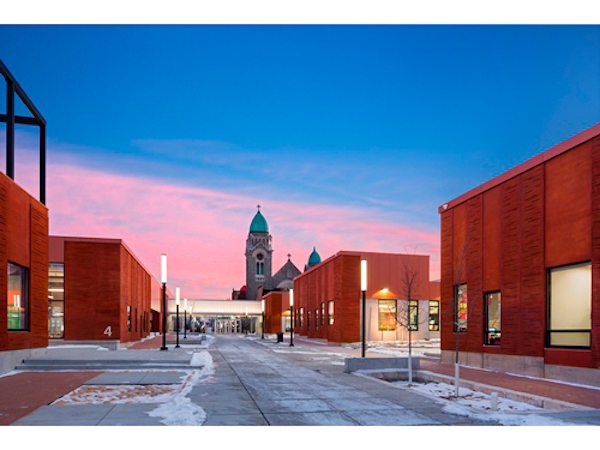 © Albert Vecerka/Esto
© Albert Vecerka/Esto
The 125,000-square-foot K-8 partnership school run by Johns Hopkins University in Baltimore is a progressive learning environment for children and a laboratory for the next generation of educators. While most elementary schools are single buildings, the School is a cluster of “containers for learning” inspired by East Baltimore’s row houses, stoops, and social civic spaces. Through its intentionally porous, safe, urban plan, and the craftsmanship of light, materiality and performance, its design respects history and supports the future of education and of its neighborhood.
Mariposa Land Port of Entry Expansion and Modernization; Nogales, Arizona
Jones Studio
 © Timmerman Photography
© Timmerman Photography
Situated amidst the high desert of southern Arizona and Sonora, Mexico, the Mariposa Land Port of Entry reimagines a border station: The public is welcomed to the U.S. by a canopy colored with reds, whites, and blues of a waving flag. Tree-lined walkways and landscape are irrigated by one million gallons of harvested rainwater. Art and poetry are integrated within the crossing experience. Vehicular processing zones guide private vehicles and commercial vehicles, carrying 40% of produce entering the U.S., to either side of a central garden “oasis”, providing officers and staff a respite on site.
Perot Museum of Nature and Science; Dallas
Morphosis Architects; Associate Architect: Good Fulton & Farrell
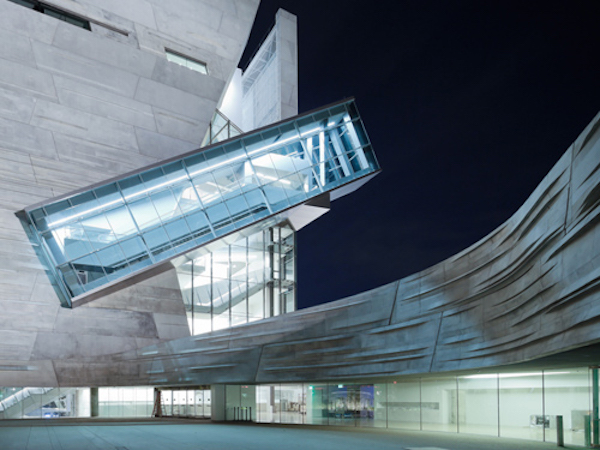 © Iwan Baan; Roland Halbe
© Iwan Baan; Roland Halbe
The Perot Museum of Nature and Science creates a new identity for Dallas’ premier science museum, engaging a broad audience with multi-sensory, immersive learning environments. Rejecting the notion of museum architecture as a neutral background for exhibits, the building itself is designed as a didactic tool for demonstrating scientific principles at work. Various strategies are used throughout the building to inspire learning and comprehension, including revealing the building structure and mechanical systems, fore-fronting energy-saving and water-reuse technologies, and integrating local ecologies into the landscaping.
Pterodactyl; Culver City, California
Eric Owen Moss Architects
 © Tom Bonner Photography
© Tom Bonner Photography
The four-story parking garage that serves as the Pterodactyl's podium predates it, but was built to withstand the load of an upward expansion. It has an open floor plan suited to contemporary office layouts, and much of its glass front is two stories high, providing an appealingly day-lit setting that a look at the exterior might not suggest. Because it is above many of the neighboring buildings, the west-facing main facade is exposed to sea breezes for passive cooling. Most glazing faces north, and south-facing sections are covered in standing-seam metal panels that reflect the hot sun away from the building.
St. Patrick’s Cathedral Conservation, Renovation & Systems Upgrade; New York City
Murphy Burnham & Buttrick Architects
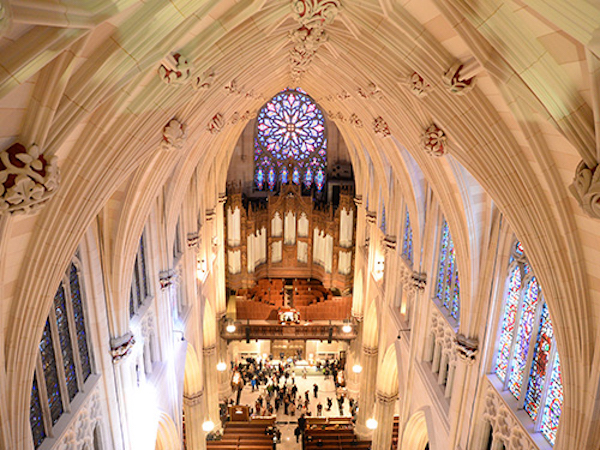 © John Baer; Building Conservation Associates; Whitney Cox; Murphy Burnham and Buttrick Architects
© John Baer; Building Conservation Associates; Whitney Cox; Murphy Burnham and Buttrick Architects
Built in 1853 by architect James Renwick, Jr., St. Patrick's Cathedral has stood as a soaring icon of the spiritual life of New Yorkers. A renovation launched in 2005 touched every building surface, from the top of its 330-foot spires to the bottom, inside and out. At the same time, innovative mechanical and life-safety systems were installed, with minimal intrusion on the splendid visual pleasures of the cathedral. The work was minutely detailed, including a forensic analysis to determine the precise specifications that Renwick made for interior paint and exterior stone mortar. A new closed-loop geothermal system that will rely on below-ground temperatures to displace 240 tons of air conditioning power and participate in winter heating as well.
US Land Port of Entry; Van Buren, Maine
Snow Kreilich Architects, Inc. and Robert Siegel Architects
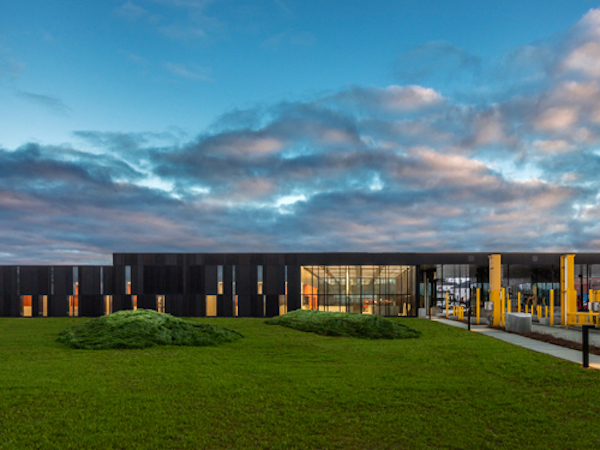 © Paul Crosby; Paul Warchol
© Paul Crosby; Paul Warchol
Set on a long, slender site on a bluff over the St. John River, the building is configured as a “Z” to provide staffers shelter from harsh winds, sleet and snow while presenting a sleek profile to visitors and passersby. The rhythmic alternation of opaque and transparent panels on the facade mimics the view between and among trees, while at the same time representing the requisite divisions between public and secure spaces that customs work demands. An exemplary outcome of the federal General Services Administration's Design Excellence Program, the Land Port of Entry skillfully couples a modern set of materials and program needs with an appreciation for regional history and landscape.
WMS Boathouse at Clark Park; Chicago
Studio Gang Architects
 © Hedrich Blessing
© Hedrich Blessing
The boathouse is part of the City of Chicago’s plan to open up access to the Chicago River. It comprises two separate structures, a boat storage facility and field house that form a portal to the water’s edge. Inside the field house, an indoor rowing tank, workout room, and afterschool study space accommodate year-round use. Working within a modest budget, the roof form uses simple linear structural elements and bendable interior plywood panels to translate the motion of rowing into a dynamic surface. Conserving energy through passive systems and keeping 100% of rainwater out of the city’s storm sewer, the project works to improve the quality of the river, supporting its ecological and recreational revival.
2016 Institute Honor awards for Interior Architecture
The 2016 AIA Institute Honor Award for Interior Architecture jury includes: Rand Elliott, FAIA (Chair), Elliott + Associates Architects; Ruth Baleiko, AIA, The Miller Hull Partnership LLP; Barbara Bestor, AIA, Bestor Architecture; James Slade, AIA, Slade Architecture and Lisa Smeltzer, State of Louisiana Facility Planning & Control.
Georgetown University School of Continuing Studies; Washington, D.C.
STUDIOS Architecture
 © Bruce Damonte
© Bruce Damonte
The architects created a space that is light and, thanks to a set of series of hanging staircases in a new four-story atrium, abundantly open for the free flow and spontaneous interactions that a more traditional grassy campus yields. An emphasis on light or transparent materials enhanced the brightness and conviviality that a campus center requires. It helped make the atrium the vital hub of the space, as well as to mitigate the lack of outdoor views from the two lower levels. A perforated metal wall treatment mounted four stories high on one side of the atrium is a contemporary curtain, alternating openness with opacity. In spaces that radiate out from the atrium, angular ceiling treatments and cutouts, horizontal piping in the wood paneling and some exposed utility lines create a visual sense of motion and lightness.
Milton Academy Pritzker Science Center; Milton, Massachusetts
William Rawn Associates, Architects, Inc.
 © Robert Benson
© Robert Benson
Two goals guided design of the Milton Academy Pritzker Science Center; make science visible and make science exciting. Floor-to-ceiling glass lines the interiors on two levels, allowing students from all grades to see activities in classrooms and dedicated “inquiry labs” where students pursue individual projects. Translucent glass zone provides privacy in front of the seminar tables, while clear glass at the lab areas emphasizes the variety of science activities. Classrooms also face the main campus green, showcasing and emphasizing the importance of science on campus.
PivotApartment; New York City
Architecture Workshop PC
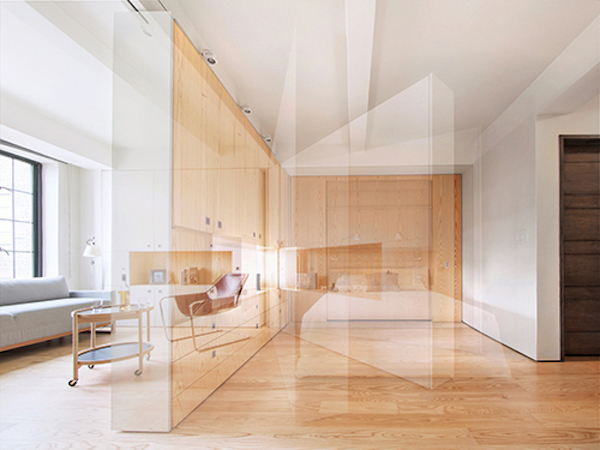 © Robert Garneau, AIA
© Robert Garneau, AIA
This single 400-square-foot studio apartment has multiple identities. The changes in personality are accomplished with the movement of a wall of meticulously designed custom cabinetry that can stand flat as part of a seamless main wall or pivot out from there to create a new wall that divides the studio. Expertly crafted, the pivoting wall contains drawers, cabinets and openings. A bed concealed in the rear wall can be pulled down into the space or left hiding, to make the space a dressing room or study. With the wall folded flat, out of the way, the studio opens up as one room amply day-lit from the vintage building's big windows. The client, who likes to entertain, can set up a large table for dinners, but when not entertaining a group, folds the table down to a smaller size for its spot next to the galley kitchen.
The Strand, American Conservatory Theater (A.C.T.); San Francisco
Skidmore, Owings & Merrill LLP
 © Bruce Damonte
© Bruce Damonte
The transformation of an abandoned century-old movie house into a highly visible, alternative performance space for San Francisco’s preeminent nonprofit theater company is a major milestone in the regeneration of mid-Market Street. The redefined space incorporates intimate theaters, educational facilities, rehearsal space, and public lobby and cafe. The program is inserted within the building’s shell, overlaying modern architectural and theater elements on top of the raw backdrop of the original cinema. The design creates inspiring civic theater and dramatically opens the lobby to the sidewalk, energizing the building and neighborhood.
Windhover Contemplative Center; Stanford, CA
Aidlin Darling Design
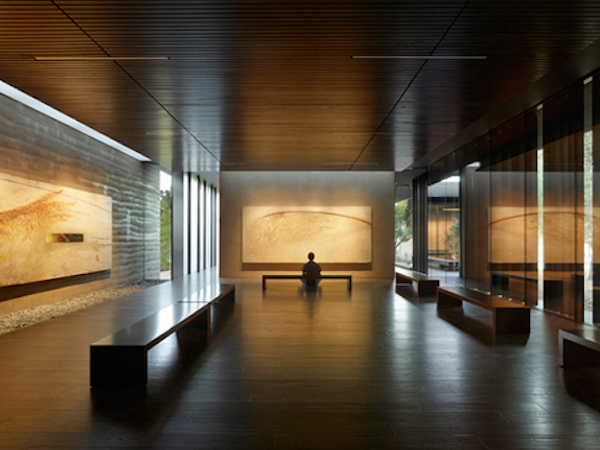 © Matthew Millman Photography
© Matthew Millman Photography
The Windhover Contemplative Center is a spiritual retreat on the Stanford campus to promote and inspire personal renewal. Using Nathan Oliveira's Windhover paintings as a vehicle, the chapel-like center provides a refuge from daily life and a space for quiet reflection. The extended progression to the sanctuary’s entry allows visitors to shed the outside world before entering. Inside, the space opens to the oak glade beyond while louvered skylights wash the paintings with natural light, unifying art, architecture and landscape. Rammed earth walls, wood surfaces, and water heighten the visitor's sensory experience acoustically, tactilely, olfactory, and visually.
2016 Institute Honor Awards for Regional & Urban Design
The jury for the 2016 Institute Honor Awards for Regional & Urban Design includes: Robert Herman, FAIA (Chair), EDA Architects; Christine Dunn, AIA, Sasaki; Mayor Nelda Martinez, City of Corpus Christi; Joel Tomei, FAIA, Joel Tomei, Architect, FAIA, NCARB, LEED AP BD+C and Christine Vina, AIA, VIA Metropolitan Transit.
Fayetteville 2030: Food City Scenario
University of Arkansas Community Design Center
 © University of Arkansas Community Design Center
© University of Arkansas Community Design Center
More than 28 percent of Arkansas children live in food-insecure situations, compared to 14.5 percent nationally. The Food City plan, which is being funded by the Clinton Global Initiative, aims to build in to Fayetteville a sustainable approach to combating hunger while permeating new development with productive green spaces. The project team envisioned a way to reduce hunger in the city by integrating a network of mid-sized agricultural sites into the urban grid as it expands. The intent is to “re-localize” food production at a scale that is larger than isolated home garden plots and smaller than the nation's current industrial scale. Future development would include not only the traditional sidewalks, parks and other public amenities, but an infrastructure that supports agriculture with spaces for growing food, distributing it, and turning waste into compost.
Smithsonian Institution South Campus Master Plan; Washington, D.C.
Architect: BIG | Bjarke Ingels Group; GHT Limited; Robert Silman Associates; Stantec; EHT Traceries; GHD; Atelier Ten; VJ Associates; Wiles Mensch Corporation; Kleinfelder; Surface Design, Inc.; FDS Design Studio
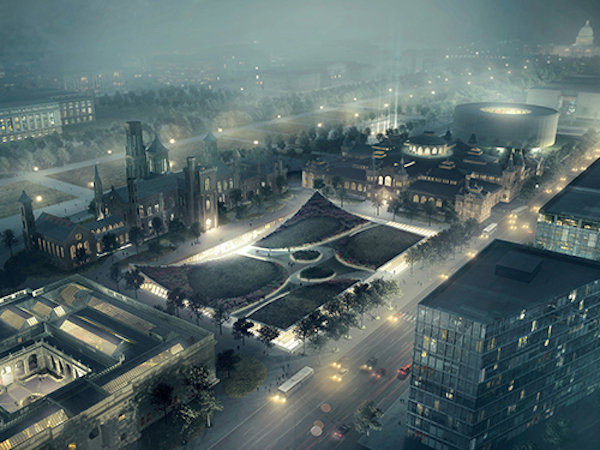 © BIG | Bjarke Ingels Group + Christopher Malheiros; BIG | Bjarke Ingels Group + Beauty & the Bit; BIG | Bjarke Ingels Group + Doug & Wolf
© BIG | Bjarke Ingels Group + Christopher Malheiros; BIG | Bjarke Ingels Group + Beauty & the Bit; BIG | Bjarke Ingels Group + Doug & Wolf
A comprehensive plan for enhancing the visitors' ability to flow through and among the Smithsonian Institution's South Campus museums, this project lays out a 20-year program of building updates and enhancements to 15 acres on the rim of the National Mall. The visual centerpiece of the project is a clever revamp of the garden adjacent to the Smithsonian's beloved castle, designed by James Renwick, Jr., in which the garden, which is the rooftop of below-ground museum space, comes to look like a carpet with its corners flipped up. The project also promises more openness within the castle, built in 1849 as the sole vessel of what is now the world's largest complex of museums. In particular, the castle's lavish Great Hall will be restored to its full grandeur with the removal of modern partition walls that reduce floor area by 40 percent.
Related Stories
| Feb 11, 2011
Research facility separates but also connects lab spaces
California State University, Northridge, consolidated its graduate and undergraduate biology and mathematics programs into one 90,000-sf research facility. Architect of record Cannon Design worked on the new Chaparral Hall, creating a four-story facility with two distinct spaces that separate research and teaching areas; these are linked by faculty offices to create collaborative spaces. The building houses wet research, teaching, and computational research labs, a 5,000-sf vivarium, classrooms, and administrative offices. A four-story outdoor lobby and plaza and an outdoor staircase provide orientation. A covered walkway links the new facility with the existing science complex. Saiful/Bouquet served as structural engineer, Bard, Rao + Athanas Consulting Engineers served as MEP, and Research Facilities Design was laboratory consultant.
| Feb 11, 2011
A feast of dining options at University of Colorado community center, but hold the buffalo stew
The University of Colorado, Boulder, cooked up something different with its new $84.4 million Center for Community building, whose 900-seat foodservice area consists of 12 micro-restaurants, each with its own food options and décor. Centerbrook Architects of Connecticut collaborated with Denver’s Davis Partnership Architects and foodservice designer Baker Group of Grand Rapids, Mich., on the 323,000-sf facility, which also includes space for a career center, international education, and counseling and psychological services. Exterior walls of rough-hewn, variegated sandstone and a terra cotta roof help the new facility blend with existing campus buildings. Target: LEED Gold.
| Feb 11, 2011
Chicago high-rise mixes condos with classrooms for Art Institute students
The Legacy at Millennium Park is a 72-story, mixed-use complex that rises high above Chicago’s Michigan Avenue. The glass tower, designed by Solomon Cordwell Buenz, is mostly residential, but also includes 41,000 sf of classroom space for the School of the Art Institute of Chicago and another 7,400 sf of retail space. The building’s 355 one-, two-, three-, and four-bedroom condominiums range from 875 sf to 9,300 sf, and there are seven levels of parking. Sky patios on the 15th, 42nd, and 60th floors give owners outdoor access and views of Lake Michigan.
| Feb 11, 2011
Iowa surgery center addresses both inpatient and outpatient care
The 12,000-person community of Carroll, Iowa, has a new $28 million surgery center to provide both inpatient and outpatient care. Minneapolis-based healthcare design firm Horty Elving headed up the four-story, 120,000-sf project for St. Anthony’s Regional Hospital. The center’s layout is based on a circular process flow, and includes four 800-sf operating rooms with poured rubber floors to reduce leg fatigue for surgeons and support staff, two substerile rooms between each pair of operating rooms, and two endoscopy rooms adjacent to the outpatient prep and recovery rooms. Recovery rooms are clustered in groups of four. The large family lounge (left) has expansive windows with views of the countryside, and television monitors that display coded information on patient status so loved ones can follow a patient’s progress.
| Feb 11, 2011
Grocery store anchors shopping center in Miami arts/entertainment district
18Biscayne is a 57,200-sf urban retail center being developed in downtown Miami by commercial real estate firm Stiles. Construction on the three-story center is being fast-tracked for completion in early 2012. The project is anchored by a 49,200-sf Publix market with bakery, pharmacy, and café with outdoor seating. An additional 8,000 sf of retail space will front Biscayne Boulevard. The complex is in close proximity to the Adrienne Arsht Center for the Performing Arts, the downtown Miami entertainment district, and the Omni neighborhood, one of the city’s fast-growing residential areas.
| Feb 11, 2011
Chicago architecture firm planning one of China’s tallest towers
Chicago-based Goettsch Partners was commissioned by developer Guangzhou R&F Properties Co. Ltd. to design a new 294,570-sm mixed-use tower in Tianjin, China. The Tianjin R&F Guangdong Tower will be located within the city’s newly planned business district, and at 439 meters it will be one of China’s tallest buildings. The massive complex will feature 134,900 sm of Class A office space, a 400-key, five-star hotel, 55 condominiums, and 8,550 sm of retail space. The architects are designing the tower with multi-story atriums and a high-performance curtain wall to bring daylight deep into the building, thereby creating deeper lease spans. The project is currently finishing design.
| Feb 11, 2011
Two projects seek to reinvigorate Los Angeles County medical center
HMC Architects designed two new buildings for the Los Angeles County Martin Luther King, Jr., Medical Center as part of a $360 million plan to reinvigorate the campus. The buildings include a 120-bed hospital, which involves renovation of an existing tower and several support buildings, and the construction of a new multi-service ambulatory care center. The new facilities will have large expanses of glass at all waiting and public areas for unobstructed views of downtown Los Angeles. A curved glass entrance canopy will unite the two buildings. When both projects are completed—the hospital in 2012 and the ambulatory care center in 2013—the campus will have added more than 460,000 sf of space. The hospital will seek LEED certification, while the ambulatory care center is targeting LEED Silver.
| Feb 11, 2011
Sustainable community center to serve Angelinos in need
Harbor Interfaith Services, a nonprofit serving the homeless and working poor in the Harbor Area and South Bay communities of Los Angeles, engaged Withee Malcolm Architects to design a new 15,000-sf family resource center. The architects, who are working pro bono for the initial phase, created a family-centered design that consolidates all programs into a single building. The new three-story space will house a resource center, food pantry, nursery and pre-school, and administrative offices, plus indoor and outdoor play spaces and underground parking. The building’s scale and setbacks will help it blend with its residential neighbors, while its low-flow fixtures, low-VOC and recycled materials, and energy-efficient mechanical equipment and appliances will help it earn LEED certification.
| Feb 11, 2011
Texas megachurch inspired by yesteryear’s materials, today’s design vocabulary
The third phase of The First Baptist Church of Pasadena, Texas, involves construction of a new 115,000-sf worship center addition. Currently in design by Zeigler Cooper, the project will include a 2,500-seat worship center (with circular layout and space for a 50-person orchestra and 200-person choir), a 500-seat chapel (for weddings, funerals, and special events), and a prayer room. The addition will connect to the existing church and create a Christian Commons for education, administration, music, and fellowship. The church asked for a modern design that uses traditional materials, such as stone, brick, and stained glass. Construction is scheduled to begin this summer.
| Feb 11, 2011
Apartment complex caters to University of Minnesota students
Twin Cities firm Elness Swenson Graham Architects designed the new Stadium Village Flats, in the University of Minnesota’s East Bank Campus, with students in mind. The $30 million, six-story residential/retail complex will include 120 furnished apartments with fitness rooms and lounges on each floor. More than 5,000 sf of first-floor retail space and two levels of below-ground parking will complete the complex. Opus AE Group Inc., based in Minneapolis, will provide structural engineering services.


